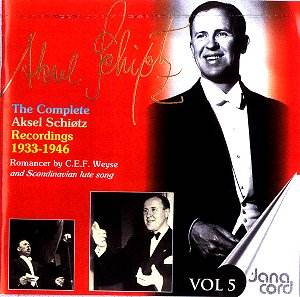Brief biographical notes on the great Danish tenor
Aksel Schiøtz can be found in my review
of Vol. 1.
The earlier volumes of this series have reissued all
the lieder and oratorio records on which Schiøtz’s fame rests
(though Vol. 8 will have a supplementary CD containing a further Dichterliebe
which came to light after the planning stage had been completed).
The remaining discs are mainly dedicated to Danish (and a few other
Scandinavian) composers and will culminate in Vol. 10 which is entirely
dedicated to Nielsen. Since this material is very little known outside
Denmark, interest obviously shifts from the performances themselves
(whose general excellence can surely be taken for granted) to the music.
The CD opens with a group of songs with lute or guitar.
Carl Michael Bellman was a Swede who enjoyed the patronage of King Gustavus
III (he who was shot in a masked ball). As a poet he was notable for
the creation of his alter ego, the poet, lover and drinker Fredman,
through whom he depicted the low life of Old Stockholm. As a composer
he made frequent recourse to folk melodies and even the tunes that are
original (such as the first on the disc) still sound like folk music.
Schiøtz recorded again the third and fourth of those found here
together with four others in 1946 and these were included in Vol. 3.
I commented that I found their charms rather too thin for it to be worth
the while of a non-Scandinavian to study the texts and so try to appreciate
them. However, the two songs in common make a much better effect here.
For one thing, the addition of the cello part enriches them considerably.
For another Schiøtz is simply in far better form. The 1946 recordings
sounded plausible enough on their own but in comparison the voice sounds
free and easy in 1944 where it sounds effortful in 1946. What is puzzling
is that, vocal matters apart, Käraste bröder is so
much more lively in 1944; in 1946 it had become dolefully heavy. Hearing
the earlier recordings left me with a much more favourable impression
of the music and I cannot imagine why the singer should have wished
to replace them. 1946, and even 1944 for that matter, was perilously
close to the operation which practically ended Schiøtz’s career
and while he had his good days right till the ended they alternated
with more effortful ones.
Though dating from 1922, the two songs from Sjöberg’s
Fridas Bok show that the cheery simplicity of Bellman remained
a part of Swedish musical thinking, and Danish too, as we see from the
two pieces by Hartmann.
The bulk of the disc consists of songs by Christoph
Ernst Friedrich Weyse. Though slightly younger than Beethoven, Weyse
had no love for that composer’s work and remained faithful to his adored
Mozart. His songs, like Mozart’s own, rarely blossom into proto-lieder,
they are simple strophic settings with the piano limited to a purely
accompanying role. Melodically they are often attractive and Carl Nielsen,
in his search for a radical simplicity, felt that the roots of his own
Danish musical identity could be traced back to Weyse. The subjects
are often religious and the poet most frequently set is Ingemann, though
En Skaal for den Mø is a translation of Sheridan’s "Here’s
to a maiden of bashful fifteen". Schiøtz for the most part
caresses these pieces inimitably into life but I have to say that the
two recordings from 1943 are a very poor substitute for his 1939 performances
of the same songs. Though in effortful voice, in 1943 he elected for
some reason to sing Lysets Engel in the higher key of B flat;
it sounds so easy and natural in A flat in 1939. Similarly effortful
is the later I fjerne Kirketaarne hist, so it was with much surprise
that I found that in this case the earlier recording is sung in the
same key. But the tessitura came much more easily to him in 1939.
Schiøtz’s first experiences as a soloist were
as part of Mogens Wöldike’s Copenhagen Boys’ Choir and the CD ends
with a group of Christmas songs with his old mentor at the organ. The
Pilgrimssang turns out to be a well-known Silesian melody found
in many Protestant hymn-books and which also has a prominent role in
Liszt’s Legend of St. Elizabeth. All this material is worth looking
out by choirs and singers searching for unhackneyed Christmas music
from around the world, though today I daresay more festively jolly tempi
might be preferred. Of Stille Nacht sung in Danish I will only
say that it is tastefully done and the original 78 must have given pleasure
to countless Danes over the years.
On the whole I feel that the charms of Weyse and the
other composers on this disc are more for the domestic Scandinavian
market than for world-wide dissemination. But if the idea of fresh simplicity
appeals to you, or if you love Nielsen and wish to investigate his roots,
you will certainly collect some fine singing along the way.
Christopher Howell


